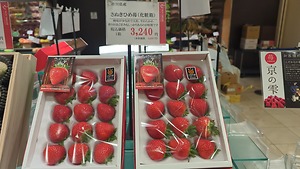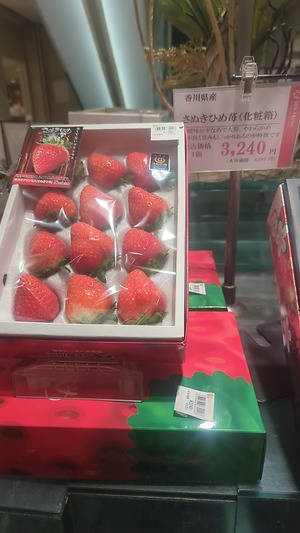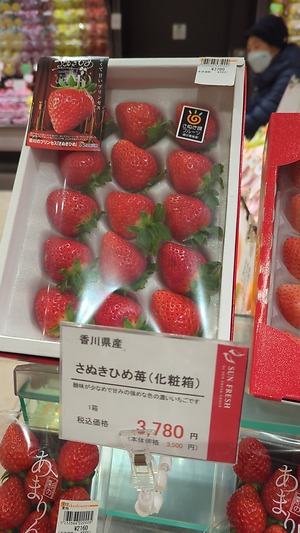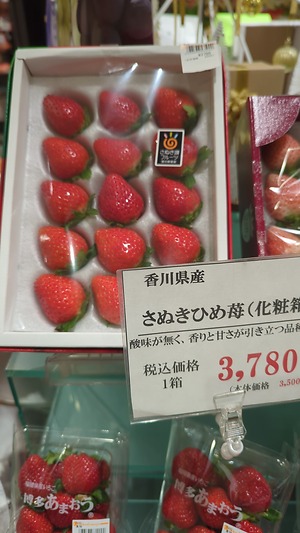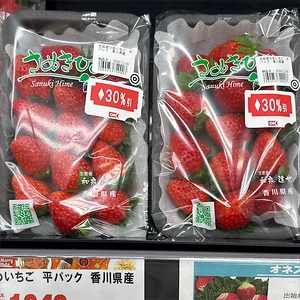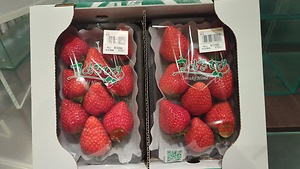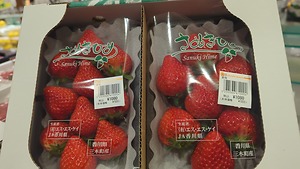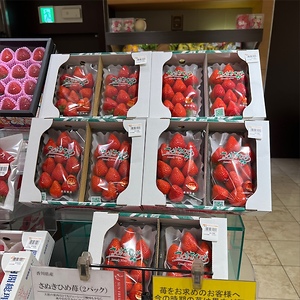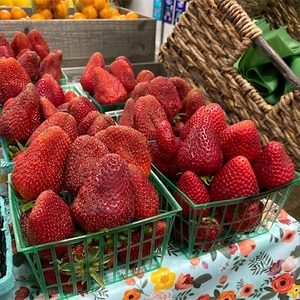


Sanuki Hime Strawberries
Estimated Inventory, ea : 0
Description/Taste
Sanuki Hime strawberries are a medium to large varietal, averaging 3 to 4 centimeters in diameter and 4 to 5 centimeters in length, and have a round to conical shape. The strawberries are capped with dark green lanceolate-shaped leaves on top of their curved shoulders, eventually tapering into a somewhat pointed, pronounced tip. Sanuki Hime strawberries are known for their saturated, bright red coloring and have a smooth, glossy, and delicate, easily bruised nature, covered in tiny yellow, green, to dark brown seeds. Underneath the surface, the variegated red, pale red, to white flesh is semi-firm, aqueous, and dense with a soft, tender, and succulent consistency. Sanuki Hime strawberries are fragrant, and their fruity aroma fills the mouth when eaten. The strawberries are known for their high sugar content and moderate acidity, creating a sweet, subtly tart taste with sugary, fruity, and floral nuances.
Seasons/Availability
Sanuki Hime strawberries are available in the winter through spring in Japan.
Current Facts
Sanuki Hime strawberries, botanically classified as Fragaria ananassa, are a Japanese hybrid belonging to the Rosaceae family. The variety was created in the early 21st century and was selectively bred as an improved strawberry with a large size, sweet flavor, and adaptability to new cultivation methods. The name Sanuki refers to the ancient name for Kagawa, the fruit’s native prefecture and site of cultivation, and Hime translates to "princess" in Japanese, which is in reference to the fruit’s beautiful appearance. Breeders hoped "Sanuki's Princess" would attract consumers to try the new strawberries after their release to commercial markets. Sanuki Hime strawberries are occasionally spelled as Sanukihime, and one of the most notable characteristics of the variety is its ability to maintain a stable sugar level throughout its season. The strawberries will not become sour at the end of their growing season, and they have a slightly longer harvest time, allowing them to be sold fresh in markets for an extended period. Sanuki Hime strawberries are primarily consumed fresh and favored for their sweet flavor and juicy consistency.
Nutritional Value
Sanuki Hime strawberries are an excellent source of manganese to maintain a healthy metabolism, vitamin C to strengthen the immune system while reducing inflammation, and potassium to balance fluid levels within the body. The strawberries also provide folate to build genetic material such as DNA and RNA, calcium to protect bones and teeth, fiber to regulate the digestive tract, and other nutrients, including vitamin A, zinc, iron, and magnesium.
Applications
Sanuki Hime strawberries have a mild and sweet flavor suited for fresh preparations. The variety has delicate, easily damaged flesh making it less suitable for cooked preparations, and it is popularly eaten straight out of hand to appreciate the fruit's flavor and tender texture. Sanuki Hime strawberries can be sliced and tossed into salads, mixed into fruit bowls, or used as a fresh topping over cereal, oats, and parfaits. They can also be halved and layered on toast, served with creamy spreads, dipped in condensed milk as a snack, or used as an edible garnish on cakes, tarts, and pies. Try blending Sanuki Hime strawberries into ice cream and gelato or using them in compotes. The fruits can also be muddled into lemonade and cocktails or cooked into jams and jellies. In Japan, Sanuki Hime strawberries are popularly layered in sandwiches with cream, used as a flavoring in mochi, or decorated on shortcakes. Sanuki Hime strawberries pair well with fruits such as blueberries, mangoes, kiwis, bananas, coconut, and oranges, vanilla, Nutella, and red bean. Whole, unwashed Sanuki Hime strawberries will keep for 3 to 7 days when stored lightly covered and dry in the refrigerator's crisper drawer.
Ethnic/Cultural Info
In the Kagawa Prefecture in Japan, Sanuki Hime strawberries are grown hydroponically in greenhouses to create an elevated, hygienic garden. Historically, strawberries in the Kagawa Prefecture were grown in outside fields beginning in the 1950s, and by the 1960s, the fruits were planted in tunnels and greenhouses. These methods of cultivation were successful, producing well-known strawberry varieties, including Nyoho, but the age demographic of strawberry farmers was growing older each day in Kagawa, leading ground-level work to become tiresome and exhausting. In 1996, Kagawa University partnered with the Kagawa Prefectural Agricultural Research Institute and JA Kagawa Prefecture to create elevated cultivation systems known as Rakuchin Saibai Cultivation. Rakuchin Saibai roughly translates to "easy cultivation" and was designed for growers to increase their productivity and streamline the commercial harvest process. This cultivation system was one of the first elevated hydroponic systems in Japan and allowed the fruits to be evenly exposed to ample amounts of sunlight. The elevated beds also encouraged older growers to continue cultivation as they no longer had to bend down to tend to the fruits. Presently, more than 90% of the strawberries produced in the Kagawa Prefecture are grown in elevated beds, and the fruits are nurtured to become large, brightly colored, sweet, and juicy. Kagawa farmers ensure that the fruits will become large during cultivation by thinning the plants to only a few fruits, guiding the plants to concentrate their sugar and nutrients into the strawberries. Once ready for harvest, Sanuki Hime strawberries are gathered by hand to prevent surface damage, and the greenhouses are also opened for consumers to pick their own fruits as a memorable experience.
Geography/History
Sanuki Hime strawberries are native to Japan and were first grown in the Kagawa Prefecture on the island of Shikoku. The variety was developed from a cross using traditional breeding techniques and was created from Sagahonoka and Miki No. 2 strawberries. Miki No. 2 was the product of a cross between Tochiotome and Sachinoka strawberries, leading Sanuki Hime strawberries to have genetic qualities from several Japanese varieties. Sanuki Hime strawberries were bred in the early 21st century at the Kagawa Prefectural Agricultural Experiment Station and were officially registered as a new variety in 2009. Today Sanuki Hime strawberries are produced only in Japan and are still grown in the Kagawa Prefecture in the cities of Sanuki, Marugame, Kan'onji, Mitoyo, Takamatsu, Higashikagawa, Miki, and Ayagawa. When in season, Sanuki Hime strawberries can be found through specialty grocers, distributors, and local markets throughout Japan.



